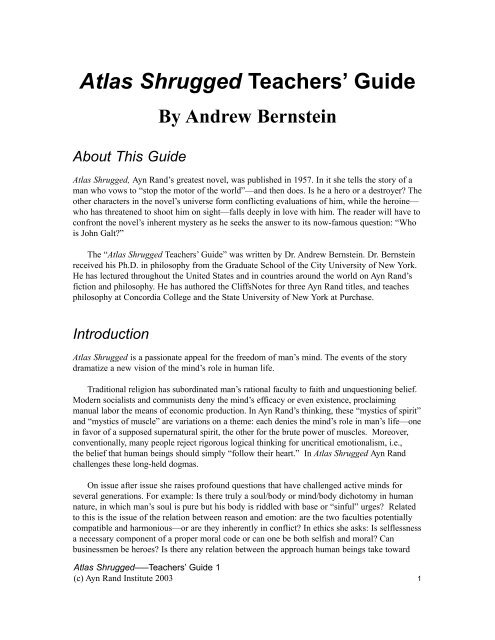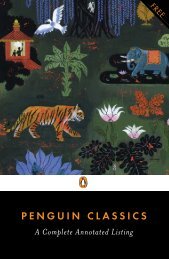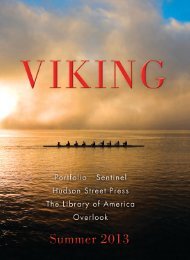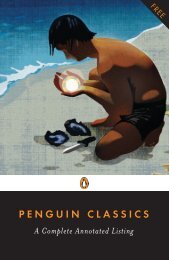Atlas Shrugged Teachers' Guide
Atlas Shrugged Teachers' Guide
Atlas Shrugged Teachers' Guide
You also want an ePaper? Increase the reach of your titles
YUMPU automatically turns print PDFs into web optimized ePapers that Google loves.
<strong>Atlas</strong> <strong>Shrugged</strong> Teachers’ <strong>Guide</strong><br />
About This <strong>Guide</strong><br />
By Andrew Bernstein<br />
<strong>Atlas</strong> <strong>Shrugged</strong>, Ayn Rand’s greatest novel, was published in 1957. In it she tells the story of a<br />
man who vows to “stop the motor of the world”—and then does. Is he a hero or a destroyer? The<br />
other characters in the novel’s universe form conflicting evaluations of him, while the heroine—<br />
who has threatened to shoot him on sight—falls deeply in love with him. The reader will have to<br />
confront the novel’s inherent mystery as he seeks the answer to its now-famous question: “Who<br />
is John Galt?”<br />
The “<strong>Atlas</strong> <strong>Shrugged</strong> Teachers’ <strong>Guide</strong>” was written by Dr. Andrew Bernstein. Dr. Bernstein<br />
received his Ph.D. in philosophy from the Graduate School of the City University of New York.<br />
He has lectured throughout the United States and in countries around the world on Ayn Rand’s<br />
fiction and philosophy. He has authored the CliffsNotes for three Ayn Rand titles, and teaches<br />
philosophy at Concordia College and the State University of New York at Purchase.<br />
Introduction<br />
<strong>Atlas</strong> <strong>Shrugged</strong> is a passionate appeal for the freedom of man’s mind. The events of the story<br />
dramatize a new vision of the mind’s role in human life.<br />
Traditional religion has subordinated man’s rational faculty to faith and unquestioning belief.<br />
Modern socialists and communists deny the mind’s efficacy or even existence, proclaiming<br />
manual labor the means of economic production. In Ayn Rand’s thinking, these “mystics of spirit”<br />
and “mystics of muscle” are variations on a theme: each denies the mind’s role in man’s life—one<br />
in favor of a supposed supernatural spirit, the other for the brute power of muscles. Moreover,<br />
conventionally, many people reject rigorous logical thinking for uncritical emotionalism, i.e.,<br />
the belief that human beings should simply “follow their heart.” In <strong>Atlas</strong> <strong>Shrugged</strong> Ayn Rand<br />
challenges these long-held dogmas.<br />
On issue after issue she raises profound questions that have challenged active minds for<br />
several generations. For example: Is there truly a soul/body or mind/body dichotomy in human<br />
nature, in which man’s soul is pure but his body is riddled with base or “sinful” urges? Related<br />
to this is the issue of the relation between reason and emotion: are the two faculties potentially<br />
compatible and harmonious—or are they inherently in conflict? In ethics she asks: Is selflessness<br />
a necessary component of a proper moral code or can one be both selfish and moral? Can<br />
businessmen be heroes? Is there any relation between the approach human beings take toward<br />
<strong>Atlas</strong> <strong>Shrugged</strong>–—Teachers’ <strong>Guide</strong> 1<br />
(c) Ayn Rand Institute 2003<br />
1
economics and the one they take toward sex? Why do some persons hate great men not for any<br />
flaws but precisely for their superb achievements?<br />
Ayn Rand’s purpose in <strong>Atlas</strong> <strong>Shrugged</strong> is to dramatize her thesis that the mind is mankind’s<br />
survival instrument, and to celebrate the great thinkers—the scientists, inventors, industrialists<br />
and artists—who have carried the human race forward.<br />
Ayn Rand had studied the history of the Scientific, Technological and Industrial Revolutions<br />
and understood that it was America’s leading minds who—benefiting from the political/<br />
economic freedom of the capitalist system—carried the country to prosperity and greatness. For<br />
example, during the late 19th century Thomas Edison—history’s greatest inventor—pioneered<br />
the phonograph, the electric lighting system, the motion picture projector and myriad other<br />
creations. Alexander Graham Bell, a Scottish immigrant, invented the telephone; and Andrew<br />
Carnegie, another Scottish immigrant, revolutionized the steel industry. Nikola Tesla, a Croatian<br />
immigrant, invented the alternating current motor and, working for George Westinghouse—<br />
inventor of the air brake for trains—pioneered the generation of electricity across vast distances.<br />
The Wright Brothers—two bicycle mechanics from Dayton, Ohio, who were self-educated in<br />
aeronautic engineering—succeeded in the first manned, powered, heavier-than-air flight, thereby<br />
opening up the aviation age. In the same year (1903) Henry Ford, a machinist from Michigan,<br />
cashed in on years of automotive research by founding the Ford Motor Company, succeeding<br />
eventually in his vision to put America on wheels. It is the heroic creators and inventors like<br />
these that Ayn Rand celebrates in <strong>Atlas</strong> <strong>Shrugged</strong>.<br />
But the United States in the universe of <strong>Atlas</strong> <strong>Shrugged</strong> is heavily dominated by an altruistic<br />
moral code, which holds that an individual has no right to his life but must serve society.<br />
Under this principle, the country is increasingly becoming a collectivist dictatorship in which<br />
individuals are rightless slaves of the state. The government implements socialist policies,<br />
confiscates patents, controls manufacturing and trade, imposes heavy taxes, establishes a massive<br />
welfare state and subsidizes unproductive businesses at the expense of productive ones—all in<br />
the name of the “public good.” The free minds, free men and free markets so characteristic of<br />
capitalism have been abrogated, submerged in an advancing statist tide. The rest of the globe has<br />
already collapsed into totalitarian “People’s States.”<br />
The result has been the destruction of worldwide prosperity and the steady decline of<br />
American civilization. With inventors robbed, innovators banned and entrepreneurs stifled, there<br />
is an ominous drop-off of productive output. American society is in despair, close to panic.<br />
Adding to the country’s woes is the mystery of the disappearing geniuses.<br />
2<br />
<strong>Atlas</strong> <strong>Shrugged</strong>–—Teachers’ <strong>Guide</strong> 1<br />
(c) Ayn Rand Institute 2003
Plot Summary<br />
Dagny Taggart, operating vice-president of Taggart Transcontinental Railroad, wonders where<br />
the great minds have gone. She and steel magnate Hank Rearden attempt to rebuild the<br />
railroad’s vital Rio Norte Line through a Colorado recently industrialized by oil developer<br />
Ellis Wyatt’s innovative method of extracting oil from shale. Dagny, despite intense social<br />
and political opposition, uses Rearden’s revolutionary product, Rearden Metal, instead of steel<br />
to build her rail. As a sign of despair, millions of Americans ask the rhetorical, supposedly<br />
unanswerable question, “Who is John Galt?” signifying a belief in the inability of man’s mind<br />
to discover life’s fundamental truths and a consequent helplessness to solve the problems of<br />
human existence. Repudiating the skeptical, pessimistic essence of the question, Dagny defiantly<br />
renames her line the “John Galt Line.” When she and Rearden successfully complete its<br />
construction, they become lovers.<br />
On vacation in Wisconsin Dagny and Rearden discover in an abandoned factory junk heap<br />
the ruins of a motor that would have revolutionized industry. Dagny is astounded: how could<br />
an invention of such immeasurable value be discarded as if worthless? Who was the genius<br />
responsible for this breakthrough—and where is he now? She initiates a quest to find the motor’s<br />
inventor, and when that fails, she hires a brilliant young scientist, Quentin Daniels, to attempt its<br />
reconstruction.<br />
With the country’s leading inventors, engineers, industrialists, artists and thinkers retiring<br />
and mysteriously disappearing, the government passes a directive chaining men to their jobs,<br />
prohibiting them from leaving. Dagny herself quits, refusing to be either a slave or a slavedriver,<br />
but returns when a catastrophic explosion—caused by a dearth of rational minds on the<br />
railroad and in the country—wrecks the Taggart Tunnel in the Rockies.<br />
She learns that there really is a “destroyer”—an agent responsible for draining the<br />
country’s best minds—when her ally and colleague Ken Danagger, of Danagger Coal, retires<br />
and disappears after a secret meeting with the mysterious stranger. When she receives a letter<br />
notifying her that Daniels has resigned from her employ, she is desperate to reach him before the<br />
destroyer does. She flies to Utah where he lives and works, but finds that she is too late; he has<br />
just left in the destroyer’s plane. Determined not to lose Daniels, she follows in her plane, and<br />
crash lands in the wildest, most remote reaches of the Colorado Rockies.<br />
Dagny survives and awakens to find herself in “Atlantis,” a valley to which have secretly<br />
retired the great minds who have disappeared from American society. She discovers that their<br />
leader is John Galt—the man of whom everybody speaks—the man for whom she has searched,<br />
because he is simultaneously the destroyer and the inventor of the motor. John Galt and the<br />
other great minds are on strike.<br />
They refuse to work or participate in a society in which individuals have no rights, one in<br />
which all are enslaved by the state. They repudiate the altruist/collectivist premises that dominate<br />
the world, i.e., the moral theory that a man must sacrifice himself for others, and the political<br />
belief that an individual exists to serve the state. The strikers stand for the opposite principles, the<br />
<strong>Atlas</strong> <strong>Shrugged</strong>–—Teachers’ <strong>Guide</strong> 1<br />
(c) Ayn Rand Institute 2003<br />
3
ethics of egoism and the politics of individualism, i.e., the moral right of a man to his own life,<br />
and the political code of an individual’s inalienable rights which must be protected, not violated,<br />
by the state. Galt and his allies uphold a system of limited government and political/economic<br />
freedom, a laissez-faire society that liberates the great creative minds to develop new ideas and<br />
products, one which protects the rights of all men to keep the product of their effort. By refusing<br />
to allow their brains to be exploited by the dictators, they intend to bring collapse to the slavedriving<br />
system, resulting in the opportunity to establish a free, capitalist system.<br />
Though Dagny agrees with their philosophy, she is not ready to abandon her railroad, and<br />
she returns to the world. But she and Galt are in love. Because Galt is a striker, however, and<br />
Dagny a “scab,” it is uncertain that their relationship can ever be fulfilled.<br />
Galt has known all along that it is men and women like Rearden and Dagny who are his<br />
main enemy. Dictators are men of force, not of the mind, and consequently are incapable of<br />
creative achievements. They do not invent, innovate or advance; they loot the creations of others,<br />
and when the creators have been killed, their systems collapse into abysmal squalor. It is Dagny<br />
and Rearden who inadvertently prop up the looter’s regime, because it is only their enormous<br />
productivity that prevents it from just such a collapse. Galt understands that the strikers’<br />
ultimate success requires that all of the major producers, including Hank Rearden and Dagny<br />
Taggart, join them. Consequently, the real conflict in <strong>Atlas</strong> <strong>Shrugged</strong> is not between strikers and<br />
management (the government), but between strikers and scabs.<br />
With the U.S. economy crumbling because of the government’s increasingly socialistic<br />
policies, the president, Mr. Thompson, is due to address the nation regarding the causes of the<br />
current emergency. Instead, Galt, using the incalculable power of his motor, pre-empts Mr.<br />
Thompson on the airwaves, and addresses the nation. He informs the American people that the<br />
men of the mind are on strike—and why—and what are the conditions of their return.<br />
The dictators, realizing that Galt is a genius, believe they must capture him and convince<br />
him to devise an economic “plan” that will rescue the country from the disastrous consequences<br />
of their policies. Knowing that Dagny, though not a striker, thinks like Galt, they have her<br />
surreptitiously followed, hoping that she will lead them to him. Fearing for his safety, she goes<br />
to him, inadvertently leading to his apprehension.<br />
Galt refuses to join the dictators. Desperate, they torture him, but he is rescued by his fellow<br />
strikers, joined now by Dagny and Rearden. They return to the valley, where Galt and Dagny<br />
are free to pursue their relationship. Finally, the corrupt statist regime collapses, and the strikers<br />
prepare to return to the world, where they will build history’s freest society.<br />
In her book The Romantic Manifesto, Ayn Rand coined a conceptual tool of literary analysis<br />
which she termed the “plot-theme.” A literary work’s plot-theme is the abstract essence of its<br />
story, of its events, presented in a succinct formulation. The plot-theme of <strong>Atlas</strong> <strong>Shrugged</strong> is: the<br />
men of the mind go on strike against an altruist-collectivist society, i.e., against the moral code<br />
of self-sacrifice and the politics of enslaving the individual to the group.<br />
4<br />
<strong>Atlas</strong> <strong>Shrugged</strong>–—Teachers’ <strong>Guide</strong> 1<br />
(c) Ayn Rand Institute 2003
Key Characters<br />
(1) John Galt<br />
<strong>Atlas</strong> <strong>Shrugged</strong> is a story about a strike. The hero, John Galt, conceives of the strike, then<br />
initiates it in action and brings it to successful resolution. His specific quest, to defend the mind<br />
and its freedom, is the purpose that drives the story’s conflict.<br />
Because of the increasingly dictatorial nature of the socialist regime, the strike must be<br />
secretive. Consequently, <strong>Atlas</strong> <strong>Shrugged</strong> is one of the rare novels in which the main character<br />
remains behind the scenes through most of the story, unobserved by either the book’s heroine,<br />
Dagny Taggart, or the reader. It is the necessarily covert nature of Galt’s activities that gives rise<br />
to the fascinating mystery that lies at the heart of the story’s events.<br />
The most important fact of Galt’s character is not his genius, but his cognitive method—his<br />
way of using his mind. He is rigorously, ruthlessly rational, identifying and respecting facts<br />
regardless of his personal feelings. For example, because of the strike he knows that he risks<br />
losing forever the chance to gain wealth by the commercial application of his motor—and the<br />
opportunity to win Dagny’s love. Because of his choice, he spends years without these important<br />
values—and their absence is painful. But he knows that the strike is right—it is the only chance<br />
he has to achieve fully all of his goals—and he does not let the pain affect his rational judgment.<br />
Such an unbreached commitment to rationality is the essence of John Galt’s character.<br />
To paraphrase him: it is not that Galt does not experience pain—or any other emotion. On<br />
the contrary, he experiences them intensely. It is that he does not permit his strong feelings to<br />
rule his judgment, his choices, his decisions, his life. Rather, he weighs facts critically, carefully,<br />
conscientiously, and conducts his life by a method of reason.<br />
It is because of Galt’s intransigent rationality that he identifies profound philosophical truths.<br />
The most revolutionary is his moral code. Galt understands that life requires the achievement of<br />
values—that just as plants must gain sunlight, water and chemical nutrients from the soil, and<br />
animals must find food and shelter from the elements, so men need to grow crops, construct<br />
homes, cure diseases, etc. Consequently, if men are to prosper on earth—or even survive—they<br />
must achieve their values, not surrender or sacrifice them. A proper moral code then is egoistic,<br />
exhorting men to attain values to promote their own lives. Galt understands that since, in<br />
principle, a man cannot live by sacrificing his values—he can only die by that method—the code<br />
of self-sacrifice is therefore a morality of death. Finally, because the values required for human<br />
existence are created by man’s mind, by his reason, the name for his revolutionary moral code is<br />
rational egoism.<br />
<strong>Atlas</strong> <strong>Shrugged</strong>–—Teachers’ <strong>Guide</strong> 1<br />
(c) Ayn Rand Institute 2003<br />
5
(2) Dagny Taggart<br />
Dagny, the story’s heroine, is a brilliant businesswoman/engineer, who runs a transcontinental<br />
railroad expertly. She has a knowledge of engineering with which to identify the merits of<br />
Rearden Metal, and the independence to fight for it against formidable social opposition. As a<br />
brilliant thinker, unreservedly loyal to the life-giving achievements of man’s mind, Dagny is<br />
distinctively an Ayn Rand heroine.<br />
It is not coincidental that Dagny is a genius specifically in the field of railroading, a branch<br />
of heavy industry. Since the story shows that intellect—not brawn in the form of manual labor—<br />
is man’s survival instrument, it follows that a rational woman could create new technologies, or<br />
recognize their value and deploy them to run an industrial concern as effectually as a man.<br />
Like John Galt and all the heroes of <strong>Atlas</strong> <strong>Shrugged</strong>, Dagny is passionately committed<br />
to man’s life and happiness on earth. Therefore, she too experiences a vibrant emotional life<br />
that directly flows from her devotion to the rational values required by human existence. For<br />
example, she shakes with excitement and panic when she realizes the true nature of the ruined<br />
motor left abandoned on a scrap heap. Further, at different times in her life she deeply and<br />
romantically loves Francisco d’Anconia, Hank Rearden and John Galt—all men as profoundly<br />
committed to the triumph of the mind and its achievements as she. Dagny, as much as Galt,<br />
illustrates the author’s point of the need to integrate reason and emotion, mind and body in<br />
human life.<br />
It is because of her profound commitment to the life-giving power of man’s mind that she<br />
loves her railroad, and is willing to endure almost any burden imposed on her by the dictators.<br />
Because of her great moral strength, her unshakeable devotion to her values, she will be the<br />
last to give up her career in the world. She will go on producing under political constraints that<br />
a lesser man would find unbearable. It is her indomitable devotion to achievement that keeps<br />
trains running, keeping alive some degree of industrial production, enabling the statists’ corrupt<br />
system to temporarily stave off collapse. Because her superb work unintentionally provides the<br />
economic prop the dictators lean on, she is Galt’s most dangerous enemy.<br />
(3) Hank Rearden<br />
Rearden is a giant of productivity, who, as a youth, worked exhausting hours in the ore mines,<br />
enabling him to eventually buy them. He builds his mines and mills into prodigiously productive<br />
concerns, and then, by means of ten years of unrelenting effort, creates a new alloy, Rearden<br />
Metal, that is vastly superior to steel. Ayn Rand’s story and theme establish that because nothing<br />
is given to man on earth, and all values must be created by his own effort, productivity is a<br />
major moral virtue. In this regard, Rearden is a moral giant.<br />
Further, the creation of economic goods and services, as the creation of all values, is<br />
fundamentally an intellectual process; such productivity is an achievement of the creative mind.<br />
6<br />
<strong>Atlas</strong> <strong>Shrugged</strong>–—Teachers’ <strong>Guide</strong> 1<br />
(c) Ayn Rand Institute 2003
Rearden, like the great inventors and industrialists of real life, is a genius, a man who fully<br />
exercises his prodigious intellectual ability.<br />
But Rearden is honestly mistaken concerning a serious philosophical issue. He believes that<br />
both the creation of material wealth and the act of lovemaking are exclusively bodily activities,<br />
devoid of spiritual meaning. The mind, or spirit, he holds, belongs to a “higher” world superior<br />
to this one—and this world’s concerns are merely vulgar or lower activities of the body. Because<br />
he holds this mistaken theory of a mind-body split, Rearden is necessarily led to devalue both<br />
his great productivity and his love relationship with Dagny. It is through his friendship with<br />
Francisco that he identifies the nobility and life-giving essence of material production—and<br />
by means of his relationship with Dagny that he discovers the profound moral virtue inherent<br />
in romantic love. Then, Rearden is internally liberated to understand and appreciate his own<br />
unsurpassed value.<br />
Like Dagny, Rearden’s love of life-promoting values is unbending; consequently, he too will<br />
long refuse to give up the productive business he cherishes, despite the impossible burdens laid on<br />
him by the dictators. Rearden, the great engine of productive achievement, who agrees with every<br />
value embodied in the strike, is nevertheless one of the two main enemies that might defeat Galt.<br />
(4) Francisco d’Anconia<br />
Francisco is one of Galt’s two college friends who join him at the strike’s inception. He is a<br />
brilliant copper magnate, who assumes the role of worthless playboy as a means to two covert<br />
ends. He gradually seeks to liquidate the great wealth of d’Anconia Copper in order to deprive<br />
the statists of its productive output and to weaken other industrial concerns dependent on it, such<br />
as Taggart Transcontinental. Additionally, his playboy persona covers his invaluable activities<br />
as recruiting agent for the strike. It is Francisco who teaches Rearden the evil of a self-sacrifice<br />
ethics, relieving him of his debilitating duties to both his mooching family and the statists,<br />
liberating him to live for his own fulfillment and to join the strike.<br />
Francisco’s joyous sense of life, the distinctive gaiety that makes him a reader favorite,<br />
proceeds from his basic philosophy. He embodies the theory Ayn Rand refers to as the<br />
benevolent universe premise. This is the theory that the world is open to the achievement of<br />
rational values, i.e., that men who pursue goals that are objectively life-promoting by a method<br />
of reason can expect achievement, success, fulfillment and happiness as their natural and<br />
expected state in life. His great achievements, and the joy he takes in life, are direct results of his<br />
deeper philosophy.<br />
Francisco’s love for Hank Rearden is based on his deep sense of justice. He sees Rearden,<br />
the heroic creator, stooped under the arbitrary restrictions and energy-sapping duties placed<br />
on him by his tormentors, mistakenly believing that his great strength should be exhausted<br />
in service to the worthless. In the novel’s title sequence, he asks Rearden what he would tell<br />
<strong>Atlas</strong> if he found him staggering under the load placed on him, believing he had an unchosen<br />
<strong>Atlas</strong> <strong>Shrugged</strong>–—Teachers’ <strong>Guide</strong> 1<br />
(c) Ayn Rand Institute 2003<br />
7
obligation to support the weak. When Rearden is unable to answer, Francisco states that the<br />
proper advice would be to exhort him to shrug, to throw off the oppressive weight and to realize<br />
that he has the inalienable right to his own life. Francisco’s wisdom teaches Rearden a new, more<br />
joyous way to live. When Rearden joins the strike, it is not just the recruiting agent’s greatest<br />
victory, it is a sublime act of justice in which Francisco takes profound personal joy.<br />
(5) Ragnar Danneskjöld<br />
Ragnar is the second of Galt’s two close college friends and, like Francisco, the earliest to join<br />
him in the strike. Though by profession Ragnar is a philosopher, he chooses to fight the statists<br />
as a pirate. He seizes by force the wealth the dictators have stolen and restores it to the original<br />
producers, the rightful owners. He sees himself as the antipode of Robin Hood, because he is the<br />
man who steals from the poor to give to the rich—or, more, exactly, he takes from the parasitical<br />
socialist regime that claims to provide for the poor in order to return wealth to the productive rich.<br />
Even more than Francisco’s, Ragnar’s character is a stylized embodiment of the virtue<br />
of justice. Men must be judged in accordance with the facts of their actions as evaluated by<br />
reference to the standard of man’s life on earth. Ragnar understands that those whose actions<br />
benefit man’s life on earth are the good—and that those whose actions harm it are the evil.<br />
The great producers of wealth, such as Dagny and Rearden, are consequently good; the looting<br />
politicians, whose oppressive laws make creativity and production impossible, are evil. Ragnar<br />
daily risks his life in support of the achievers and the requirements of their life-giving success.<br />
(6) Hugh Akston<br />
Hugh Akston was chairman of the Department of Philosophy at the Patrick Henry University,<br />
where he taught Galt, Francisco and Ragnar. He is the greatest living philosopher, and the last<br />
great advocate of reason—or the first of their return. Professor Akston became more than a<br />
teacher to the three young geniuses entrusted to him—he became a mentor and father figure.<br />
Early on, Professor Akston recognized the merit of his best student’s brilliant insight and plan,<br />
and joined the strike. He understands that his three great students have transfigured the world,<br />
and when Dagny asks in the valley for his estimate of their accomplishments, he responds: “You<br />
asked me whether I was proud of the way my three sons had turned out. I am more proud than I<br />
had ever hoped to be. I am proud of their every action, of their every goal—and of every value<br />
they’ve chosen.”<br />
(7) James Taggart<br />
James Taggart is president of the railroad and Dagny’s older brother. But there all resemblance<br />
to his sister ends. He is the story’s most prominent villain, who opposes Dagny on every issue.<br />
Taggart loathes Francisco, Rearden and Ellis Wyatt, as well as Dagny, because of their ability to<br />
8<br />
<strong>Atlas</strong> <strong>Shrugged</strong>–—Teachers’ <strong>Guide</strong> 1<br />
(c) Ayn Rand Institute 2003
create the values on which human life depends. He is a nihilist, one who is motivated by a well<br />
of hatred for the good, who seeks to destroy good men and the values on which their lives are<br />
based. He wrecks the Phoenix-Durango Railroad primarily to destroy Dan Conway. He seeks to<br />
celebrate the establishment of an Argentine “People’s State” because the nationalization of all its<br />
remaining private property will ruin Francisco. He has sex with Lillian Rearden in order to hurt<br />
her husband. He desires to torture Galt, to hear him scream, ultimately to murder him, though<br />
his own demise will then follow shortly. He drives his wife, Cherryl, to her death because the<br />
essence of her character is an unabashed hero-worship, an unstinting admiration for mankind’s<br />
noblest achievers.<br />
Taggart supports the ethics of self-sacrifice and the politics of collectivism not because he<br />
believes they will benefit the poor or the weak, but because they enable him to attack the rich<br />
and the strong. He recognizes that these doctrines lead directly to Nazism and Communism,<br />
totalitarian systems which enslave and murder the great independent minds he hates. He is filled<br />
with what Ayn Rand terms “envy,” hatred of the good for being the good; consequently, his<br />
unrelieved desire to wreak destruction is similar to the most evil men of human history—such<br />
20th century collectivist mass murderers as Adolf Hitler, Josef Stalin, Mao Tse-tung and Pol Pot.<br />
<strong>Atlas</strong> <strong>Shrugged</strong>–—Teachers’ <strong>Guide</strong> 1<br />
(c) Ayn Rand Institute 2003<br />
9
Theme and Philosophical Meaning<br />
Ayn Rand stated that the theme of <strong>Atlas</strong> <strong>Shrugged</strong> is: the role of the mind in man’s existence—<br />
and, as a corollary, the demonstration of a new moral philosophy: the morality of rational selfinterest.<br />
In the story Ayn Rand shows by means of both the mind’s presence and its absence that<br />
man’s mind is his survival tool.<br />
The story fully dramatizes this principle, which had been only hinted at in The<br />
Fountainhead. Each species, the author argues, is endowed by nature with specific means by<br />
which to attain survival. For example, birds have wings, elephants formidable size, gorillas<br />
great strength, lions claws and fangs, antelopes foot speed, etc. These animals survive by purely<br />
physicalistic means. But man has no great size, strength or speed. He has no wings to fly, no fur<br />
to keep him warm, no claws with which to kill his prey. Compared to many animal species, he is<br />
a physically unprepossessing creature. The survival tool with which nature has endowed him is<br />
his reasoning mind.<br />
The strike shows in action that every value on which man’s life depends is a product of<br />
his mind—and Galt’s radio address provides the explanation. The houses men inhabit have to<br />
be built, which requires knowledge of architecture, engineering, geometry—which requires<br />
reason. The food men eat must be grown, necessitating knowledge of agricultural science—of<br />
irrigation, cultivation, fertilization, crop rotation, and genetic engineering—which requires the<br />
mind. Similarly, medicines to cure or treat diseases, which must be researched and developed,<br />
and involves the study of biology—which requires the faculty of reason. The same is true<br />
of freedom, which is based on a written Constitution and a Bill of Rights, which requires<br />
knowledge of political philosophy, and consequently the mind. Such examples can be multiplied<br />
many times, but the principle is clear: man’s mind is the ultimate source of every value his life<br />
depends on. Galt, by withdrawing the mind from human society, precipitates decline on a global<br />
scale, demonstrating that when the cause of prosperity is removed, collapse is inevitable.<br />
Galt makes explicit to the strikers the moral code they had always implicitly accepted<br />
and lived by—the creed of an individual’s right to pursue values and personal happiness. The<br />
great creators and achievers had always understood as a subconscious premise that their own<br />
life is the highest value, and that their specific accomplishments which further it are sanctified<br />
by that alone. They had grasped that individuality is a central, ineradicable part of human<br />
nature—that only individuals live, think, act and experience joy. At an emotional level, they had<br />
comprehended that individual human beings have the inalienable right to their own lives, and to<br />
pursue the values that promote it. But they had been battered their entire lives by the opposite<br />
code—the altruist belief that men must sacrifice for society, that they are rightless serfs whose<br />
only moral value lies in the service they provide for others. The thinkers and producers join<br />
Galt because they recognize that his creed of rational egoism is the code of life, and that any<br />
morality requiring men to renounce or sacrifice values is a code of death.<br />
The strikers recognize that the mind needs political/economic freedom, and that statism<br />
stifles all creative thought. For man’s survival instrument to flourish, and for men consequently<br />
10<br />
<strong>Atlas</strong> <strong>Shrugged</strong>–—Teachers’ <strong>Guide</strong> 1<br />
(c) Ayn Rand Institute 2003
to prosper, human beings must be free to think—and to express and act on their thinking.<br />
Only other men can prevent an individual from acting on his rational judgment, and only by<br />
initiating force against him. Therefore, man’s ability to survive as a rational being necessitates<br />
his protection from the initiation of force. The fundamental right of an individual is the right to<br />
life—which implies the right to think. It is this principle of individual rights which serves as the<br />
moral legitimacy of government—for only a system of limited constitutional government can<br />
safeguard man’s fundamental right and lead to flourishing human life. It is for this reason that<br />
Galt and his allies support unrestricted laissez-faire capitalism.<br />
It is not an accident, Ayn Rand argues, that the freest societies of history—England and<br />
the United States—pioneered the Industrial Revolution and achieved mankind’s highest living<br />
standards. Nor is it a coincidence that the most politically repressed nations—Dark Age<br />
Europe, Soviet Russia, Communist Cuba—fail to progress, and sink into miserably low living<br />
standards. Man’s survival instrument—his mind—must be free. Thinkers cannot identify new<br />
truths when they are subject to torture, imprisonment or execution for doing so. The story of<br />
Galileo, threatened with torture for discovering scientific truth, and of his predecessor, Giordano<br />
Bruno, burned at the stake for the same, are eloquent examples of the mind’s fate in a politically<br />
repressive society. Patrick Henry’s immortal line—“Give me liberty or give me death”—is<br />
true at the deepest level: when the mind has liberty, it discovers the knowledge and creates<br />
the abundance on which human life depends—but when the mind is stifled or enslaved, such<br />
creative intellectual work is suppressed, and the inevitable results are destruction and death.<br />
Galt recognizes that the alternative with which reality confronts man is: reason, freedom and<br />
prosperity—or brute force, statism and collapse.<br />
Since a proper moral code stipulates the inalienable right of individuals to pursue their own<br />
happiness, and because laissez-faire capitalism is the only system that safeguards such freedom,<br />
it is the only moral political/economic system. Fascism, Communism, Socialism and all forms<br />
of statism involve the initiation of governmental force against the individual, thereby abrogating<br />
his fundamental right to his own life. Reason, egoism and freedom—these are the principles<br />
supported by Galt and his fellow strikers.<br />
<strong>Atlas</strong> <strong>Shrugged</strong>–—Teachers’ <strong>Guide</strong> 1<br />
(c) Ayn Rand Institute 2003<br />
11
Suggested Study Questions<br />
12<br />
1. Why does John Galt believe that the men of the mind must go on strike in order to achieve<br />
their goals?<br />
2. Given that Rearden and Dagny philosophically agree with the strikers, why do they<br />
oppose them in action?<br />
3. Ayn Rand observed that it took the rational achievements of Dagny, Rearden, et al., to<br />
uphold the statist regime. What does this say about the relative power of good and evil?<br />
4. Eddie Willers can be understood as Everyman at his moral best. What philosophical role<br />
does he play in the story? Why is he stranded in the desert in the end? What is the deeper<br />
significance of his fate?<br />
5. Why does Rearden feel compelled to carry on his back both a mooching family and a load<br />
of political parasites? What moral code is embodied in such actions?<br />
6. Ayn Rand held that the world’s problems went deeper than politics or even ethics, that<br />
they were epistemological, involving men’s choice to use their rational faculty or not.<br />
How does the Taggart Tunnel catastrophe illustrate her insight?<br />
7. Lillian Rearden and James Taggart hold essentially the same motivation. Identify it, and<br />
discuss its nature.<br />
8. Dr. Robert Stadler is a great thinker destroyed by his belief that the mind has no role in<br />
practical life. Discuss the causes, nature and consequences of his theory-practice, mindbody<br />
split.<br />
9. How is Francisco d’Anconia able to keep intact his unclouded gaiety even though he loses<br />
so much because of the strike, including Dagny?<br />
10 Explain Ragnar Danneskjöld’s statement that Robin Hood is the one man he is out to<br />
destroy. What is the deeper moral meaning of his claim?<br />
11. Why is Mr. Thompson eager to negotiate with Galt, even though they hold contradictory<br />
theories of government? What makes him so willing to brush aside principles and shortsightedly<br />
seek to solve merely the emergency of the moment?<br />
12. Though Ayn Rand’s stated purpose in writing <strong>Atlas</strong> <strong>Shrugged</strong> was to “provide a moral<br />
defense of capitalism,” she nevertheless presents unscrupulous businessmen—e.g., James<br />
Taggart and Orren Boyle—as villains. What is the difference between these two and<br />
Dagny and Rearden? Why is it that the second pair is an example of capitalism, but the<br />
first pair is not?<br />
<strong>Atlas</strong> <strong>Shrugged</strong>–—Teachers’ <strong>Guide</strong> 1<br />
(c) Ayn Rand Institute 2003

















